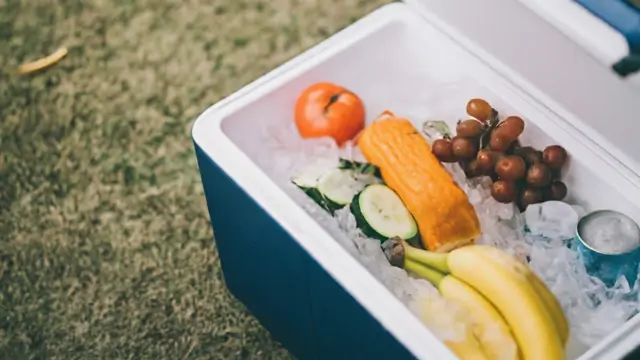Can you use dry ice to keep food cold: The Ultimate Guide
Can you use dry ice to keep food cold? The answer is a resounding yes, but taking precautions is very required.
Greetings, fellow outdoor enthusiasts! I’m Jaden, a seasoned camper with a passion for elevating the camping experience.
Today, I’m here to share insights on a game-changer for your outdoor culinary escapades—using dry ice to keep your food cold.
This technique is a must-know for campers, hunters, fishermen, and anyone hosting outdoor events. Now, let’s embark on this chilly adventure together.
Understanding the Basics: What is Dry Ice?
Dry ice is not your ordinary ice. It’s carbon dioxide in solid form, boasting a frosty temperature of -109.3°F (-78.5°C).
This extreme coldness makes it a powerhouse for keeping your provisions refreshingly cool.
How Does Dry Ice Work to Keep Food Cold?
Imagine having a cooling agent that doesn’t melt into a watery mess. Dry ice does just that.
As it sublimates, it releases carbon dioxide gas, creating a cooling effect that maintains a consistent temperature inside your cooler.
This makes it incredibly efficient for preserving food over an extended period.
Safety precautions to take when handling dry ice
Handling dry ice comes with unique challenges, and it’s crucial to keep safety in mind. Here’s how to ensure you navigate through it smoothly [1]:
Before using dry ice:
- Read the Safety Data Sheet (SDS) to learn about the properties and hazards of dry ice.
- Know the emergency procedures for your workplace or activity.
- Understand material compatibility. Some materials, such as nitrile gloves, can be damaged by dry ice.
- Use only the dry ice you need. Avoid unnecessary exposure.
During use:
- Work in a well-ventilated area. Dry ice can release carbon dioxide gas, which can displace oxygen and cause suffocation.
- Protect your skin. Wear closed-toed shoes, a lab coat, eye protection, and thermally insulated gloves. If you experience skin or eye contact, clothing soaked with liquid, or inhalation of cold vapors, follow first aid procedures.
- Use tongs to handle dry ice. Never touch it with your bare hands.
- Store dry ice in an appropriate container. Avoid airtight containers. Styrofoam is a good storage material. If a container of dry ice appears swollen or bulging, contact emergency services immediately.
After use:
- Dispose of dry ice properly. Place it in a well-ventilated area for it to sublimate. Never dispose of it in regular trash. In case of a spill, increase ventilation and seek technical assistance if needed.
- Store unused dry ice in a well-ventilated area. Keep it away from incompatible materials.
- Be aware of the hazards of storing large quantities of dry ice. Do not store it in confined spaces without proper ventilation.
- Wash your hands and forearms thoroughly with soap and water after handling dry ice.
Choosing the right cooler for dry ice
When it comes to handling dry ice, picking the right cooler is key. Consider what you’ll be cooling and for how long.
Single-day trips? Opt for Styrofoam coolers or urethane-insulated boxes. For larger and longer applications, go for a molded or plastic cooler ( Note: Don’t put dry ice in metal, plastic, or glass containers, unless they’re specially made for it.)
Ensure the cooler has a lid that doesn’t seal completely or has a drain. This is crucial for ventilation, preventing a buildup of gas as the dry ice turns directly from solid to gas (sublimates).
- Styrofoam for Short Trips: For quick adventures, Styrofoam coolers are your go-to. They’re lightweight, insulated, and perfect for keeping things cool for a day.
- Plastic for Extended Use: If your camping expedition spans more days, opt for a molded or plastic cooler. These are ideal for larger quantities and longer durations.
Tips to use dry ice to keep food cold

- Choose a Well-Insulated Container:
To ensure prolonged freshness, opt for a well-insulated cooler. The better the insulation, the longer your food stays chilled.
- Strategic Placement:
Place the dry ice on top of your food to allow efficient sublimation while keeping your provisions safe from direct contact.
- Right Amount, Right Results:
The key to success lies in the quantity of dry ice. Aim for 5-10 pounds (2.3-4.5 kg) per 24 hours, adjusting based on your container size and food volume.
- Keep it Closed, Keep it Cold:
Treat your cooler like a fortress. Minimize openings to retain the icy environment within. A sealed container equals a prolonged chill.
- Guard it From the Curious:
Dry ice isn’t a plaything. Keep it out of reach of children and pets, as ingesting it can be hazardous.
How long will dry ice last?
Dry ice is a formidable ally, but it has its limits. After 18 to 24 hours, its sublimation slows, and your food may inch towards room temperature.
Prioritize safety—check the temperature before serving. If it exceeds 40°F (4.4°C), bid farewell to that portion.
Your camping culinary adventures should be as cool as dry ice itself. Happy camping, and may your food always be refreshing!
Read more about these DIY Ice Packs For Camping
Conclusion:
There you have it, a comprehensive guide to using dry ice like a camping pro, not only for keeping food fresh but also for a myriad of other applications.
As you embark on your outdoor adventures, remember the mantra: stay safe, stay cool, and explore the endless possibilities of dry ice.
Visit our blog to learn more about alternative methods for Keeping Food Cold While Camping.